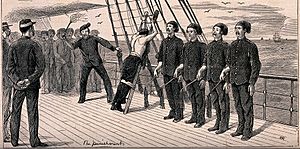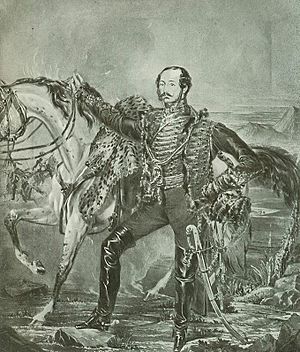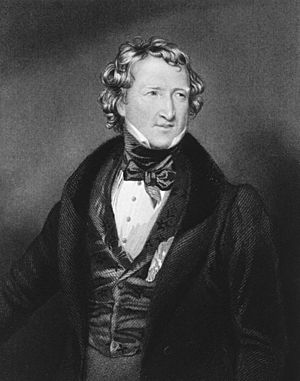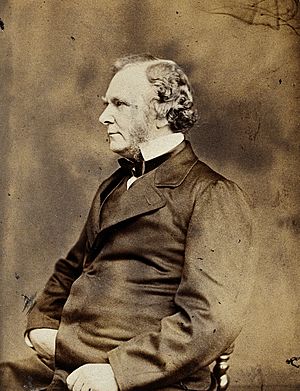Death of Frederick John White facts for kids
Frederick John White was a soldier in the British Army's 7th Hussars. In 1846, he was given a punishment called flogging, which meant being whipped. He received 150 lashes with a "cat of nine tails" on June 15. After the punishment, White was taken to the hospital. He seemed to get better at first but then got worse and sadly died on July 11.
An army doctor said White died from natural causes. However, the local church leader heard about the flogging and told the coroner, Thomas Wakley. Wakley was against flogging and ordered more medical checks. A doctor named Erasmus Wilson found that White's death was directly caused by the flogging. On August 4, a jury agreed that the flogging led to White's death. They also asked for this punishment to be stopped.
This case brought a lot of attention to the idea of ending flogging. Soon after, the head of the British Army, the Duke of Wellington, ordered that no soldier could receive more than fifty lashes. The prime minister, Lord John Russell, also said he supported ending the punishment completely. Even with these promises, flogging stayed in the army until 1881. It was finally abolished as part of the Childers Reforms.
Contents
What Was Flogging?
Flogging was a type of physical punishment used in the British military. It involved whipping a person's back. This punishment was allowed by a law from 1689 called the Mutiny Act. By the 1700s, it was very common. Sometimes, soldiers were sentenced to as many as 1,000 lashes. For very high sentences, the punishment was given in parts. This allowed the person's skin to heal a little in between.
It was not unheard of for soldiers to die from floggings. This happened more often in places like British India than in Britain itself. When a death occurred, it was usually blamed on fever or illness, not on the punishment itself.
The Incident and Punishment
Frederick John White was a soldier in the 7th Hussars. He was born in January 1819 in Nottingham. Before this event, he had been punished for breaking rules with extra drills. He had only been in the hospital once before, after being kicked by a horse.
White was arrested and faced a military court a few days later. The court sentenced him to 150 lashes. This was the most lashes the court was allowed to give. The "cat of nine tails" was a whip made of nine knotted leather straps. This was likely White's first time being flogged. In the 7th Hussars, the regiment's farriers (men who cared for horses) gave the punishment. They were told to hit as hard as they could. If they didn't, they could be punished themselves. One soldier said that the 7th Hussars flogged more harshly than other units. In other units, young trumpeters often gave the punishment.
The flogging happened on June 15, 1846. About 200 to 300 soldiers watched in the riding school. White was told his sentence. Then, he took off his shirt and was tied by his arms and legs to a ladder. The ladder was nailed to a wall. Around 9 AM, the regiment's commander, Lieutenant-Colonel John Hames Whyte, ordered the punishment to begin. Lieutenant Ireland then gave the order to Farrier-Major Critton.
Critton started the whipping. He and Farrier Evans took turns after every 25 or 50 lashes to rest their arms. Sergeant Patman counted the strokes. Each stroke happened about every twelve seconds. White's shoulders started bleeding after the first 20 strokes. But he did not cry out in pain at any time. After 100 lashes, the whip was swapped for a fresh one. White then asked the farriers to strike "lower, lower." They adjusted their aim. He might have wanted them to hit skin that was already damaged and numb to the pain.
Colonel Whyte and the army doctor, Dr. James Law Warren, were present. Dr. Warren did not check on White during the punishment. At one point, White asked for water, and it was given to him. At least one corporal and one private fainted while watching. One witness said six men fainted. By the end, White had lost a lot of blood, which soaked his trousers. This happened even though rules said flogging should not break the skin. His shirt, soaked in water, was put on his back. He was covered with his overcoat and taken to the barracks hospital. Colonel Whyte told the regiment he was sorry for such a "brutish exhibition." He said he was determined to stop such behavior in the regiment.
White's Treatment and Death
White whistled as he entered the hospital. An orderly and another patient cleaned the blood from his still-bleeding back. White was not seen by a doctor for another 90 minutes. Then, Dr. Warren visited with Colonel Whyte. Neither officer spoke to White or looked at his back. Dr. Warren returned at 10 PM to examine White's back. It was wounded in an area about 6 inches (15 cm) high and 4 to 5 inches (10 to 13 cm) wide between his shoulder blades. White's pulse was not checked on the first day.
White's back was washed with lukewarm water. It was treated with a special ointment and a lead-based medicine. Dr. Warren put him on a strict diet. He ate a quarter pound (0.11 kg) of potatoes and three-quarters of a pound (0.34 kg) of bread each day. On July 9, his diet was changed to a "half diet." This included one pound (0.45 kg) of bread, half a pound (0.23 kg) of meat, one liter of soup, and two liters of tea. White could not eat all his food after July 5. For example, he ate only one potato on July 6. While in the hospital, White said he was not well enough to be flogged because of an existing chest problem.
The skin on White's back healed quickly. But from early July, his health got worse. White complained of pain in his right side. By July 6, he was unable to leave his bed. On July 9, White's back and chest broke out in boils. These were treated with a mustard plaster. On July 11, White lost feeling in his hands and feet. He also had trouble passing urine. His back was inflamed, and his skin was cold and damp. First Class Staff Surgeon John Hall was called to see White. He arrived but found it was too late to help. White died in his presence at 8:30 PM.
Autopsies and Investigation
Dr. Warren performed a medical examination on White's body. Dr. Hall and Dr. Francis Reid helped him. Warren concluded that White died from inflammation around his lungs and heart. He wrote this on the death certificate. Hall sent a separate report to the army, saying White's back had healed well. White's body was sent for burial. The church leader was told White died of a liver problem. However, the church leader became suspicious when he heard White had been flogged. He reported the death to the Middlesex coroner, Thomas Wakley. Wakley was a reformer and against flogging. He also founded The Lancet, a medical journal.
Wakley looked into White's case. He thought the army's examination was too quick. So, he ordered an official investigation called an inquest. He asked Dr. Horatio Grosvenor Day, a surgeon, to do a second examination. When Day reported, Wakley said there had been a misunderstanding. He claimed White's spine had not been checked. This allowed him to order a third examination. This one was done by Erasmus Wilson, a famous skin doctor. Such a detailed investigation was very unusual for a common soldier's death at that time.
Wilson reported that the inflammation from the flogging went deep into the skin. He found that the muscles around White's spine were "soft and pulpy." He thought this was from the muscles tightening during the flogging. However, this softening might have been caused by a blood infection, which doctors didn't know about yet. Wilson also found that White's internal organs were inflamed. He said this was a direct result of the flogging and helped cause White's death. He believed that the healed skin hid the serious internal problems. Wilson also reported that White had suffered "shock" to his nervous system, inflammation of his left lung, and boils on his back. Dr. Day disagreed with Wilson's findings. He did not think the lung area could be affected by the muscles.
The Inquest
Wakley's inquest first met on July 15 at 8 PM. It was held in a room at the George IV Inn near Hounslow Heath. Thirteen jury members were sworn in. Army officers and members of the public attended. The jury visited the barracks to see White's body. There, Wakley found that a piece of skin from White's back was missing. It was about 57 square centimeters (9 square inches) and had been removed during Dr. Warren's examination. Wakley also found that the army had not tried to contact White's family. He stopped the inquest at 10 PM. This allowed time to find family members, for Day's examination to be done, and for Dr. Reid and Dr. Hall to be called to speak.
The inquest met again on July 20 at the same inn at 9:30 AM. Many people attended, including five judges. A lawyer, Mr. G Clark, was there to represent the 7th Hussars. Clark insisted that the regiment's adjutant, Ireland, stay throughout the inquest. He said Ireland was giving him instructions. The jury worried that Ireland might scare the soldiers who were called to speak. But Wakley allowed him to stay. White's brother had been found and attended as his closest family member. After finding the problem with Day's examination not checking White's spine, Wakley stopped the second day at 3:45 PM.
The inquest started again at 9:30 AM on July 27, after Wilson had finished his examination. Wakley questioned Dr. Warren. Warren said he had seen White on the day of the punishment and found him fit to receive it. He denied saying that White had died from the flogging, even though a witness in the hospital reported it. He stated that he found sticky areas on White's heart during his examination. He also said that, apart from inflammation of the heart and blood vessels, White was healthy. Day and Reid said that the hot summer weather of 1846 might have contributed to White's death.
The jury gave their decision on the fourth and final day of the inquest, August 4. They believed White's death was caused by the flogging. It was legally tricky to decide who was responsible. At that time, "wounding" meant breaking the skin. White's skin had healed by the time he died. In their findings, the jury asked the public to send requests to parliament to stop flogging.
The Impact of the Case
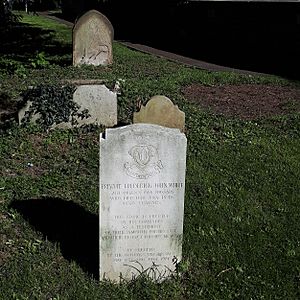
The inquest's decision led to arguments among doctors about the cause of death. George Ballingall, a professor of military surgery, wrote in a medical journal. He questioned if Wakley and Wilson were fair. He also questioned the quality of Wilson's evidence. Wilson wrote several articles in The Lancet. He argued that many doctors did not understand that skin was an important organ that could affect the rest of the body.
The case led to the creation of the Flogging Abolition Society. Wakley was its leader, and they first met in 1846. A popular song called The Flogging Excitement at Hounslow was sung around the time of the inquest. It supported ending flogging. Its last lines were:
Tied up hands and feet to a ladder,
While the sound of the cat reached afar,
Oh, Britain thy deeds make me shudder,
Remember poor White, the Hussar
Soon after the inquest, the head of the British Army, the Duke of Wellington, ordered a change. The most lashes a soldier could receive was reduced to fifty. On August 7, the prime minister, Lord John Russell, was asked in parliament about flogging. He said Wellington had ordered that all soldiers sentenced to be flogged must be checked by doctors. This was to make sure they were healthy enough. He also said weather conditions should be considered. Russell stated that he looked forward to the day flogging could be stopped in the army. But he and Wellington thought it was still needed for the near future.
He said his government had built many prisons for the army. These could be used instead of physical punishment. He noted that the number of men flogged each year had fallen. In 1838, it was 1 in 108 soldiers. By 1845, it was 1 in 189. He also mentioned that good behavior payments, pay raises for long service, and giving officer jobs to regular soldiers helped discipline. Libraries, savings banks, and gardens also helped improve soldier behavior.
The use of flogging in the army was limited in 1859. In peacetime, only soldiers considered "bad character" could be flogged. But it was still freely allowed in wartime. The 1868 Cardwell Reforms further limited its use in peacetime. It was only for mutiny and very serious bad behavior. In wartime, it was still allowed for these, plus desertion, drunkenness on duty, and other misbehavior. Flogging sentences were limited to 25 lashes in 1879. By then, the punishment was rarely used. All physical punishment in the army was finally stopped in 1881 as part of the Childers Reforms.




